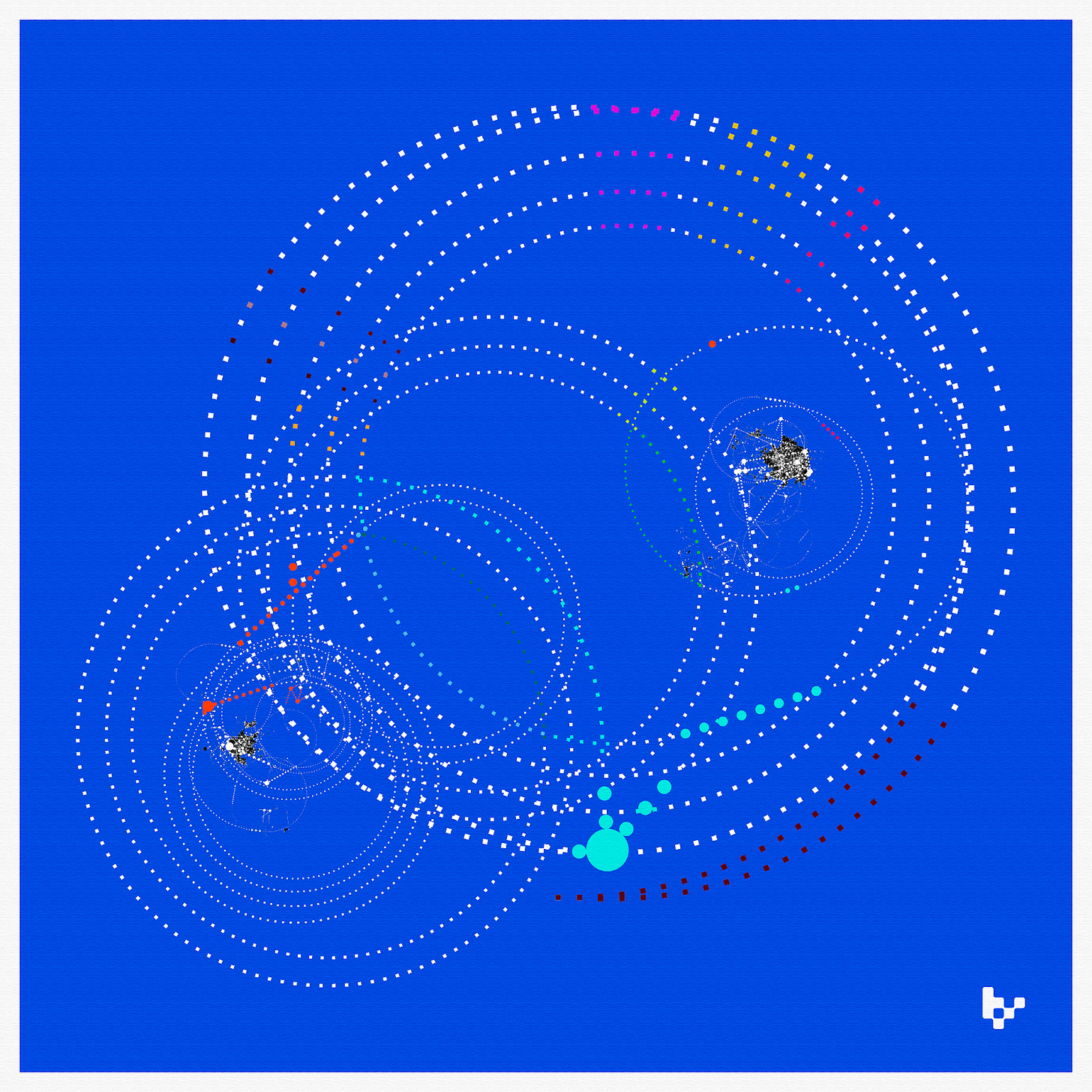Hi readers, the following is an excerpt from the inaugural issue of the Variant Newsletter, out today. To read the full newsletter, as well as stay up to date on the team’s thinking, subscribe here.
To commemorate the newsletter launch, we’ve commissioned a special art piece by generative artist Giorgio Balbi for those who subscribe on Mirror, which you can mint for free (+gas) through June 11.
Assets vs. ideology in web3 social networks
by Li Jin
I see two main approaches to building in web3 social: asset-first or ideology-first.
The asset-first approach focuses on users' desire for profit, unlocked through digital ownership, which places money at the forefront of the platform. Financialized features allow users to spend, collect, and earn within the network.
BitClout fit squarely in the asset-first approach and enabled users to bet on the trajectory of prominent profiles through trading creator coins, creating a speculative social game at the center of the network. Lens is another example of an asset-first web3 social network, where users’ posts are instantiated as NFTs that can be collected and purchased, with the top creators earning upwards of $90,000 from collectible posts. PFP NFT communities can also be thought of as asset-first social networks: interest groups that are incepted through collecting assets. In all of these instances, users’ motivations for participating aren’t purely intrinsic, but involve, at least to some degree, the potential for financial gain. It’s like collecting stamps or baseball cards: it’s fun and enjoyable, but also, what if they could be worth something someday?
In contrast, the ideology-first approach toward building in web3 social entails appealing to users’ values and ideals. That means emphasizing characteristics enabled by blockchains, including censorship-resistance, data privacy, and portability of social graphs and content. The actual user experience may closely resemble a web2 social product, but the underlying architecture involves some portion of data being stored on-chain, and all the benefits that come with it.
My view is that web3 social networks will succeed by taking the asset-first approach, i.e. creating opportunities for profit that will appeal to users. In other words, these networks are not purely social networks, but socioeconomic networks. This approach also creates a more clearly differentiated user experience that should in theory resonate more broadly. (Income is a universal need, whereas ideals can feel abstract to many.) This also mirrors the path for wider adoption elsewhere in crypto, including in NFTs, DeFi, and even L1s: desire for financial gain bootstrapped new networks and apps and played a pivotal role in their adoption.
To be clear, leaning into an asset-first approach doesn’t mean catering only to speculators and creating a financialized game that’s easily manipulated. Social networks can be easily polluted with spam and bad actors who detract from the network, creating a negative network effect. Unlike a DeFi lending protocol where all liquidity is valuable even if it comes from users with financial motivations, in social networks the quality of content and users matters. Simply rewarding all content creation, reach, or usage is too blunt of a financial incentive, risking an environment that’s full of spam or useless content, or is downright toxic.
A successful financial game at the heart of a web3 social network should combine both intrinsic and extrinsic motivations. Stealcam, a content-sharing platform where fans earn a cut of the sale when NFTs they own are subsequently purchased for a higher price, attracted both profit-motivated traders who engaged in the hot potato game of trading images back and forth, but also appealed to true fans who wanted to keep the content their favorite creators had made as collectibles.
Taking an asset-first approach will also allow networks to construct novel social graphs. Social networks are constructed around distinct social graphs, which form the basis of their network effects: Facebook got its start by leveraging your real-world friend / college graph; LinkedIn mapped out your professional connections; and TikTok’s social graph is based on your interests, inferred from your behaviors on the app. An asset-based social network can pioneer and popularize an ownership graph, wherein users connect based on shared onchain ownership. This goes beyond simply clustering users into PFP communities, which is the primitive version of this idea that we’ve already seen. As the density of users’ ownership history grows onchain, over time, this ownership graph can richly reflect users’ interests, supplementing users’ self-professed interests or real-world contacts.
In sum, there is a unique window of opportunity right now to build web3 social networks. Existing web2 social companies like Twitter and TikTok are facing upheaval, and users are hungry for something new.
Our vision for web3 social networks is rooted in leveraging the distinct capabilities of crypto to offer a differentiated user experience that rewards continued usage.
Disclaimer: This post is for general information purposes only. It does not constitute investment advice or a recommendation or solicitation to buy or sell any investment and should not be used in the evaluation of the merits of making any investment decision. It should not be relied upon for accounting, legal or tax advice or investment recommendations. You should consult your own advisers as to legal, business, tax, and other related matters concerning any investment. Certain information contained in here has been obtained from third-party sources, including from portfolio companies of funds managed by Variant. While taken from sources believed to be reliable, Variant has not independently verified such information. Variant makes no representations about the enduring accuracy of the information or its appropriateness for a given situation. This post reflects the current opinions of the authors and is not made on behalf of Variant or its Clients and does not necessarily reflect the opinions of Variant, its General Partners, its affiliates, advisors or individuals associated with Variant. The opinions reflected herein are subject to change without being updated.



I see the future, maybe Farcaster is An asset-based social network.
How do you evaluate Veve as an example of a social financial web3 network? Is it successful?